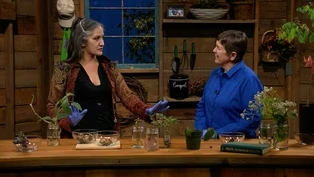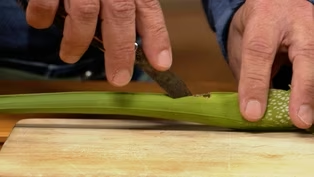Virginia Home Grown
Pitcher plant conservation
Clip: Season 25 Episode 8 | 8m 5sVideo has Closed Captions
Discover Virginia’s native carnivorous plant!
Peggy Singlemann visits Dr. Phil Sheridan at Meadowview Biological Research Station in Woodford to learn about pitcher plants and explore a rare gravel bog ecosystem where these unique native plants are being preserved. Featured on VHG episode 2508, October 2025.
Problems playing video? | Closed Captioning Feedback
Problems playing video? | Closed Captioning Feedback
Virginia Home Grown is a local public television program presented by VPM
Virginia Home Grown
Pitcher plant conservation
Clip: Season 25 Episode 8 | 8m 5sVideo has Closed Captions
Peggy Singlemann visits Dr. Phil Sheridan at Meadowview Biological Research Station in Woodford to learn about pitcher plants and explore a rare gravel bog ecosystem where these unique native plants are being preserved. Featured on VHG episode 2508, October 2025.
Problems playing video? | Closed Captioning Feedback
How to Watch Virginia Home Grown
Virginia Home Grown is available to stream on pbs.org and the free PBS App, available on iPhone, Apple TV, Android TV, Android smartphones, Amazon Fire TV, Amazon Fire Tablet, Roku, Samsung Smart TV, and Vizio.
Providing Support for PBS.org
Learn Moreabout PBS online sponsorship>>Welcome to Meadowview Biological Research Station, home to the National Pitcher Plant Collection.
So we've got the largest collection of pitcher plants in the United States.
>>Interesting, are all of these native, or are some from other parts of the United States?
>>Well, two species are native to Virginia, the yellow pitcher plant, and the purple pitcher plant, and the rest are found in the southeastern United States.
>>So are we in the northern most part, or do they continue on up north?
>>We are at the northern limit for the yellow pitcher plant, which reaches its home in southern Virginia.
Purple pitcher plant goes on up into Canada.
>>Excellent, and I know these are very unique, in that they actually live in areas that are very starved of nutrients.
So how do they get their food and energy?
>>So they get their food through regular channels, like other plants.
So pitcher plants have photosynthesis, but in the bogs that they're found in, they're acidic and they're low in nutrients, and so these plants have evolved the ability to catch and digest insects and absorb nutrients for growth and reproduction.
>>So they've learned, they've adapted to kind of pull the additional nutrients they need from the insects.
>>That's right.
There's actually evolutionary pressure on the vegetable kingdom for plants to be carnivorous in certain conditions, basically where you have a sunny, wet, nutrient-poor habitat, if the other conditions are present in a plant family, then you might see the evolution of carnivory in that plant.
>>That's fascinating.
Well, how are those insects drawn in?
>>Insects are attracted by nectar and odor.
>>Fascinating.
>>And then they come to the pitcher, and some insects fall in, and then they get digested by both bacterial and enzymatic action from the plant.
>>That's fascinating.
I understand they take a special condition, a true bog, and that you've got one here.
>>Yeah, we have a bog right back in the woods with our native pitcher plants.
You wanna go see?
>>Oh, I'd love to see it, yes.
>>Let's go.
>>Okay.
Here we are walking through Eastern forests, but these plants are more moisture-loving than what I'm used to.
>>You're here on our Central Virginia Preserve, the northern most native pitcher plant bog in Virginia, on a globally-rare gravel bog.
This is a ocean strand from three to five million years ago.
And so on this portion of the preserve, we've got a a hillside seepage bog where water, moving down through the sand, hitting a clay layer, and percolating out on the side slopes here.
>>Oh!
>>What is this?
>>Yes, look.
>>What did you just find?
>>I just found a pitcher plant.
That's beautiful.
>>Imagine that.
>>Imagine that.
But you know, in my mind, I would've wanted it lower and into more, I'll say of a boggy situation that I'm thinking of in my head.
>>That's right, a lot of people, Peggy, when we talk about these plants, they think they're down in a swamp somewhere.
And they're really not in swamps.
Swamps are forested wetland.
They're actually, at least in Virginia, located on headwater spring systems.
And so here we have the springy ground, fresh, clean water coming through the sand, very low nutrient, with sphagnum moss.
You're not getting flood waters, which you'd get down in a swamp.
And all that together allows these plants, it's the conditions where these plants would occur.
>>Interesting, and it's right along the roadway that you created for access into this space.
>>That's right.
>>But yet the water is flowing underneath that sphagnum moss.
>>Yeah, flowing horizontally.
>>Yes.
>>Horizontally, in groundwater seepage, and then vertically of course, when it rains.
>>Right.
Because you had shared, these are basically thriving in nutrient-poor sites, and that that water is leaching the nitrogen away.
>>Nitrogen and potassium too, it's a number of nutrients that could be leached out.
And so part of that syndrome then, when you get that set up, and you have a sunny habitat as well, is you have the conditions for the evolution of carnivorous plants.
And this with it's one of the low-growing pitcher plant species, it holds water in the leaves, and largely through the action of insects in the pitchers, the insects are broken down, and nutrients made available to the plants.
It's a whole ecosystem that's being studied.
>>Yes, and each one of these is holding a little puddle of water.
And I can see there's insects, even mosquitoes in there.
So what type of mosquito is in there?
>>It's called Wyeomyia smithii.
It's an endemic mosquito of pitcher plants.
And those insects are really important.
Some of the studies that have been done, if you don't have the associate insect species, the water is loaded with algae.
>>Oh my.
>>And you can see the water here.
>>It's crystal clear, >>Clear, maybe cloudy, depending on how many insects are in a pitcher.
But that complex of insects is actually processing the captures so you don't get those algae blooms.
But if you miss components, you can, sound familiar, you get something polluted, you get an algal outbreak.
>>Yeah, but do all pitcher plants process their prey the same way?
>>Similarly, yeah, they have pitcher, a funnel, that captures and coalesces nutrients via insects.
This one has more water because it's open to the rain.
The trumpet species have caps on the pitcher that really prevent rainwater from getting in.
Those are more dry digestion versus a wet digestion here.
>>Interesting, but to get that rainwater, you need to have open air.
And I noticed that you've done a lot of work around here, Dr.
Phil.
>>That's right, this, when we first got this property, there were a lot of hardwoods, big hardwoods here, also sucking water outta the ground, so we had to remove those.
There were way too many pines, we cut those out.
The bog had very little sphagnum, there was only one small patch.
And we knew we had to open it up, get sunlight in here.
And once we did that, sphagnum covered the whole hillside here in bog.
>>Interesting.
>>Yeah.
>>But I also know you've got some more wetland species moving in.
You've got the Clethra moving in.
>>Well, you know, it's kind of one of the associates you do find on the edges of a bog, Clethra.
We've got alder coming in from the swamp.
But then we have more characteristic bog species like poison sumac that's only found in bogs.
And that's a really good indicator of the high quality here.
>>Yes, but also, you really don't want this alder here, do you?
>>It's part of the system.
I'll come out here with a tri-arc blade and cut it down at my leisure.
>>Right, because that's gonna be fixing nitrogen.
>>It's fixing nitrogen, and it's part of it, we just don't want it to be a dominant.
>>Right, right.
>>So we can correct it.
>>Right, 'cause we wanna preserve >>That's right.
>>Our serracenias here.
>>And that's what volunteers are for.
So Meadowview being a nonprofit, that's the kind of winter activity that volunteers can help with, clearing brush in the bog.
And we have those kind of options open if people want to help out.
>>Yeah, it's like anything else, trying to slow down nature.
You can't really halt it, but to slow it down in its succession toward woodlands, it takes time and effort.
>>And that's a very good point.
So some people would say, "Well, Phil, isn't that gardening?"
And I would say, "No, that's called managing a habitat."
Because many of the processes that were here prior to settlement aren't.
And so we're now responsible for the management of the bog since there's, so fire, even though we burn here, some of the browsers are missing.
So we are really required to come in and do our contribution to keep the habitat open for the rare plants.
And that's really state of the art in conservation biology today.
>>And that's really the purpose of Meadowview Biological.
>>That's right, that's right.
>>Yes, which is doing so much because you've got two locations.
>>That's right.
>>So do you have any plans for more?
>>The only limitation is money.
>>Oh, that's with everything.
(Phil and Peggy laugh) >>So here, our goal was, I think 156 acres, we're now at 85.
And if we meet them, there are more bogs to protect, and then we'd move on to that, if we get to that point.
>>It's so important, the work you're doing.
People just don't understand how we need to preserve areas, to protect all aspects of the ecosystem, even these cute little pitcher plants.
>>This is it, this is the end of the road for pitcher plants in Virginia.
The Meadowview Preserve System is it, I mean, we're the last best example of native pitcher plants in habitat in Virginia.
>>I know this has been a lifetime project for you, and I'm just so pleased with your successes, and I congratulate you.
>>Well, thank you, Peggy.
>>Yeah.
Well, I'll tell you what, let's go look for some more, okay?
>>Okay.
>>All righty.
Video has Closed Captions
Clip: S25 Ep8 | 26m 46s | Explore the world of deadly plants to discover their benefits! (26m 46s)
Plants that can be Toxic to Pets
Video has Closed Captions
Clip: S25 Ep8 | 7m 36s | Learn about common and uncommon plants with toxic properties (7m 36s)
Video has Closed Captions
Clip: S25 Ep8 | 7m 30s | Learn how to identify poisonous plants (7m 30s)
Video has Closed Captions
Clip: S25 Ep8 | 3m 31s | Learn how to grow Venus flytraps at home (3m 31s)
What is inside a pitcher plant?
Video has Closed Captions
Clip: S25 Ep8 | 5m 56s | Discover how many insects pitcher plants catch. (5m 56s)
When Tomatoes were Considered Poisonous
Video has Closed Captions
Clip: S25 Ep8 | 2m 44s | Discover why tomatoes did not catch on in Europe for hundreds of years (2m 44s)
Providing Support for PBS.org
Learn Moreabout PBS online sponsorship

- Home and How To

Hit the road in a classic car for a tour through Great Britain with two antiques experts.












Support for PBS provided by:
Virginia Home Grown is a local public television program presented by VPM






